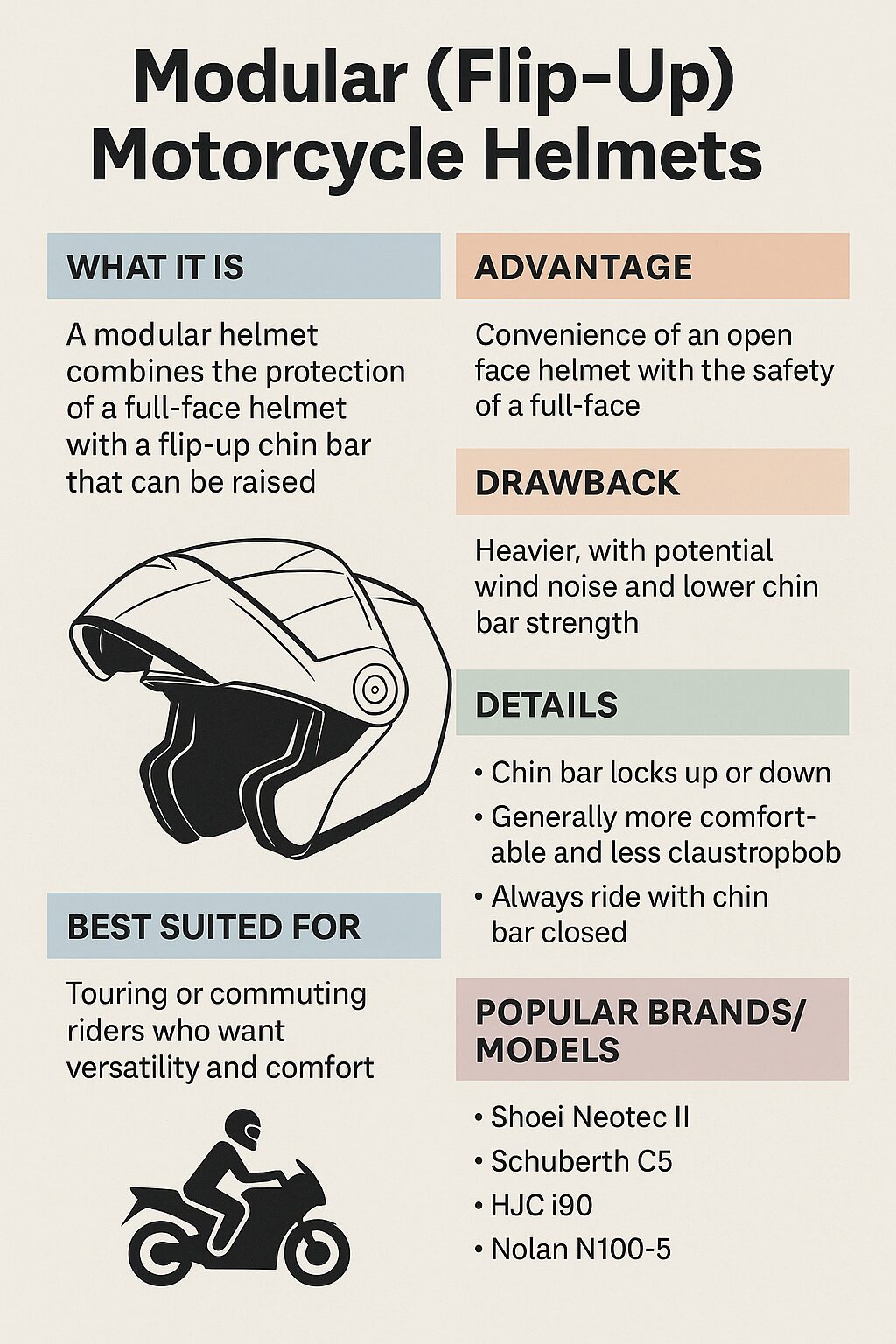What are Modular Motorcycle Helmets
Modular motorcycle helmets, often called flip-up helmets, combine the protection of a full-face design with the convenience of an open-face helmet. Their defining feature is a hinged chin bar that can be lifted, allowing riders to switch between full coverage and an open-face feel without changing helmets. This versatility makes them popular among touring riders, commuters, and anyone who values both safety and comfort. Designed to meet modern riding needs, modular helmets balance aerodynamics, ventilation, and convenience—perfect for riders who want flexibility on the road.
Read more best rated motorcycle helmets…
There isn’t a strict, universal classification, but they can generally be grouped into 5 main types based on design and functionality:
- Standard Modular Helmets
- Chin bar flips up with a single button.
- Most common type.
- Good balance of safety and convenience.
- Dual-Homologated Modular Helmets (P/J Certified)
- Can legally be used as both a full-face (P) and an open-face (J) helmet.
- Safer for riders who switch between city cruising and highway riding.
- Flip-Over (Rotating 180°) Modular Helmets
- Chin bar rotates all the way to the back, not just up.
- Provides a more aerodynamic and stable open-face feel.
- Example: Shark Evo-One 2, Nolan N100-5.
- Adventure / Dual-Sport Modular Helmets
- Blend of modular and ADV helmet styles.
- Come with a peak/visor for off-road use but also a flip-up chin bar.
- Example: Schuberth E1, Nolan N70-2 X.
- Smart / Bluetooth-Integrated Modular Helmets
- Built-in Bluetooth intercom, speakers, and mic.
- Some have HUD (heads-up display) or camera integration.
- Example: Sena Outrush R, Livall Smart Helmet.
In short: There are 5 main types of modular motorcycle helmets (standard, dual-homologated, flip-over, adventure, smart).
Here’s a refined breakdown of up to 15 distinct types of modular (flip-up) motorcycle helmets—each offering unique features, styles, or use-cases to suit different riders:
Modular motorcycle helmets (sometimes called flip-up helmets) are a hybrid between full-face and open-face helmets. They usually have a chin bar that can be lifted up, making them versatile.
| Type | Best Product | Brand | Sizes | Brief Overview | Best Suited For… |
|---|---|---|---|---|---|
| Everyday Versatile | Shoei Neotec 3 | Shoei | XS–XXL | Premium comfort, excellent noise control, touring build | Daily commuters & long-distance riders |
| Max Airflow Flip-Over | Shark EVO-GT | Shark | XS–XL (some XXL) | Chin-bar rotates fully back, huge airflow | Hot-weather riders, urban & touring mix |
| Dual P/J Flexibility | Nolan N100-6 | Nolan | XXS–XXL | Legal as both full-face & open-face | Riders who switch modes often |
| Adventure Touring | Schuberth E1 | Schuberth | XS–XXXL | Modular with off-road style peak | Adventure & dual-sport touring |
| Ultra-Quiet Touring | Schuberth C5 | Schuberth | XS–XXXL | Wind-tunnel quiet, luxury comfort | Highway touring, noise-sensitive riders |
| All-in-one Bluetooth | Sena Impulse | Sena | S–XXL | Built-in Bluetooth & comms | Tech-savvy riders, group rides |
| Lightweight Carbon Sport | AGV Sportmodular Carbon | AGV | XS–XXL | Carbon shell, sporty & light | Sport-touring, premium riders |
| Budget-Friendly Entry | ILM 902L | ILM | S–XXL | Affordable modular with basics | New riders, budget shoppers |
| Long-Distance Comfort | HJC RPHA 91 | HJC | XS–2XL (some 3XL) | Excellent comfort & touring focus | Touring riders, all-day comfort |
| Aggressive Sport Aero | Nexx X.Vilitur Carbon | Nexx | XS–XXL | Aerodynamic, sporty carbon modular | Style-conscious sport riders |
| Sun-Visor Commuter | LS2 Advant FF906 | LS2 | XS–3XL | Drop-down sun visor built-in | City commuting, mixed riding |
| Pre-wired for Intercom | Nolan X-1005 | Nolan | XXS–XXL | Ready for comm units (N-Com) | Riders adding intercom later |
| Urban Daily Rider | Bell SRT Modular | Bell | XS–XXL | Lightweight, easy urban use | Everyday city commuting |
| Eyeglass-Friendly | HJC C91 | HJC | XS–3XL | Eyewear-friendly interior channels | Riders wearing glasses daily |
| Hot-Climate Ventilation | Shark EVO-ES | Shark | XS–XL (some XXL) | High ventilation, flip-back chin bar | Riders in tropical/hot climates |
Factors to Consider Before Buying Modular Motorcycle Helmets
When choosing a modular (flip-up) helmet, safety isn’t the only factor. Comfort, convenience, and riding style all play a role. Here are the key things to check before buying:
1. Safety Certifications
- Look for DOT (US), ECE 22.06 (Europe), or Snell approval.
- If you plan to ride with the chin bar open, ensure it is dual-homologated (P/J certified).
2. Weight
- Modular helmets are heavier than full-face helmets because of the hinge mechanism.
- Choose lightweight materials like fiberglass composite or carbon fiber for long-distance comfort.
3. Comfort & Fit
- Make sure the helmet fits snugly without pressure points.
- Check for removable liners, moisture-wicking fabric, and good padding for extended rides.
4. Ventilation & Noise Control
- Good airflow is essential for hot weather and long rides.
- More vents = cooler ride, but may also increase wind noise. Some helmets have advanced noise-reduction designs.
5. Mechanism Quality
- The chin bar’s locking system should feel sturdy and easy to operate with gloves on.
- High-quality hinges last longer and offer better safety.
6. Visibility Features
- Wide field of view for better peripheral vision.
- Anti-fog visors (Pinlock ready) and drop-down sun visors are useful in different weather conditions.
7. Extra Features
- Integrated Bluetooth systems for communication and navigation.
- Options for camera mounts or HUD (heads-up display) in smart helmets.
8. Price vs. Value
- Entry-level modular helmets cost ~$150–$250.
- Mid-range models $300–$500 add comfort and safety upgrades.
- Premium/smart helmets can exceed $700 but include advanced tech.
9. Riding Style
- Touring riders may prioritize comfort, noise reduction, and Bluetooth.
- Commuters often want dual-homologation for flexibility in city riding.
- Adventure riders benefit from modular/ADV hybrids with peaks and off-road features.
Advantage/ Drawback:
| Advantage | Drawback |
|---|---|
| Easy on/off and quick stops | Heavier than full-face models |
| Better ventilation and comfort | Potential for wind noise |
| Ideal for communication and glasses wearers | Possible chin bar vulnerability |
| Emergency accessibility | Higher price |
FAQs About Modular Motorcycle Helmets
1. What is a modular motorcycle helmet?
A modular helmet (also called a flip-up helmet) is a hybrid between a full-face and an open-face helmet. It has a chin bar that can be lifted up, offering both full protection and open-face convenience in one design.
2. Are modular helmets as safe as full-face helmets?
When worn in the locked, closed position, a modular helmet provides protection similar to a full-face helmet. However, because of the hinge mechanism, it may be slightly less rigid than a traditional full-face. Always choose models with DOT, ECE, or Snell certification for verified safety.
3. Can I ride with the chin bar up?
Yes, but only if your helmet is dual-homologated (P/J certified). These models are legally approved for both full-face and open-face use. Standard modular helmets are safest when used with the chin bar down and locked.
4. Are modular helmets heavier than other helmets?
Yes, they are usually a bit heavier than open-face or full-face helmets because of the hinge and locking mechanism. Premium materials like carbon fiber can reduce weight.
5. Who are modular helmets best for?
They are ideal for touring riders, commuters, and adventure riders who need versatility—such as being able to talk, drink water, or take a quick break without removing the entire helmet.
6. What are the disadvantages of modular helmets?
- Slightly heavier due to hinge mechanisms.
- Can be noisier than a full-face helmet at high speeds.
- Usually more expensive than entry-level open-face helmets.
7. Do modular helmets have Bluetooth integration?
Many modern modular helmets come with built-in Bluetooth communication systems or are designed to easily fit aftermarket Bluetooth kits. Some advanced models even include HUD displays or cameras.
8. How much does a modular helmet cost?
Prices typically range from $150 for entry-level models to $600+ for premium or smart-integrated versions. Features, brand reputation, and safety certifications affect cost.
Conclusion
Modular motorcycle helmets offer the perfect balance between the protection of a full-face helmet and the convenience of an open-face design. With so many types—from touring-friendly Bluetooth models to lightweight carbon fiber versions and adventure-ready hybrids—there is a modular helmet for every rider. By considering safety certifications, weight, comfort, ventilation, and riding style, you can find the helmet that best suits your needs. Investing in the right modular helmet not only enhances comfort but also ensures maximum safety and enjoyment on every ride.

Hi, I’m Suvil—a lifelong motorcycle enthusiast with over 10 years of riding experience. My passion for two wheels inspired me to create Best Motorcycle Helmet, a space dedicated to helping riders make smarter decisions about their gear, bikes, and riding lifestyle. I currently ride a sleek white Kawasaki Ninja 400 and love sharing insights from the road to guide both new and seasoned riders. Learn more about my journey and motorcycling experience here.

